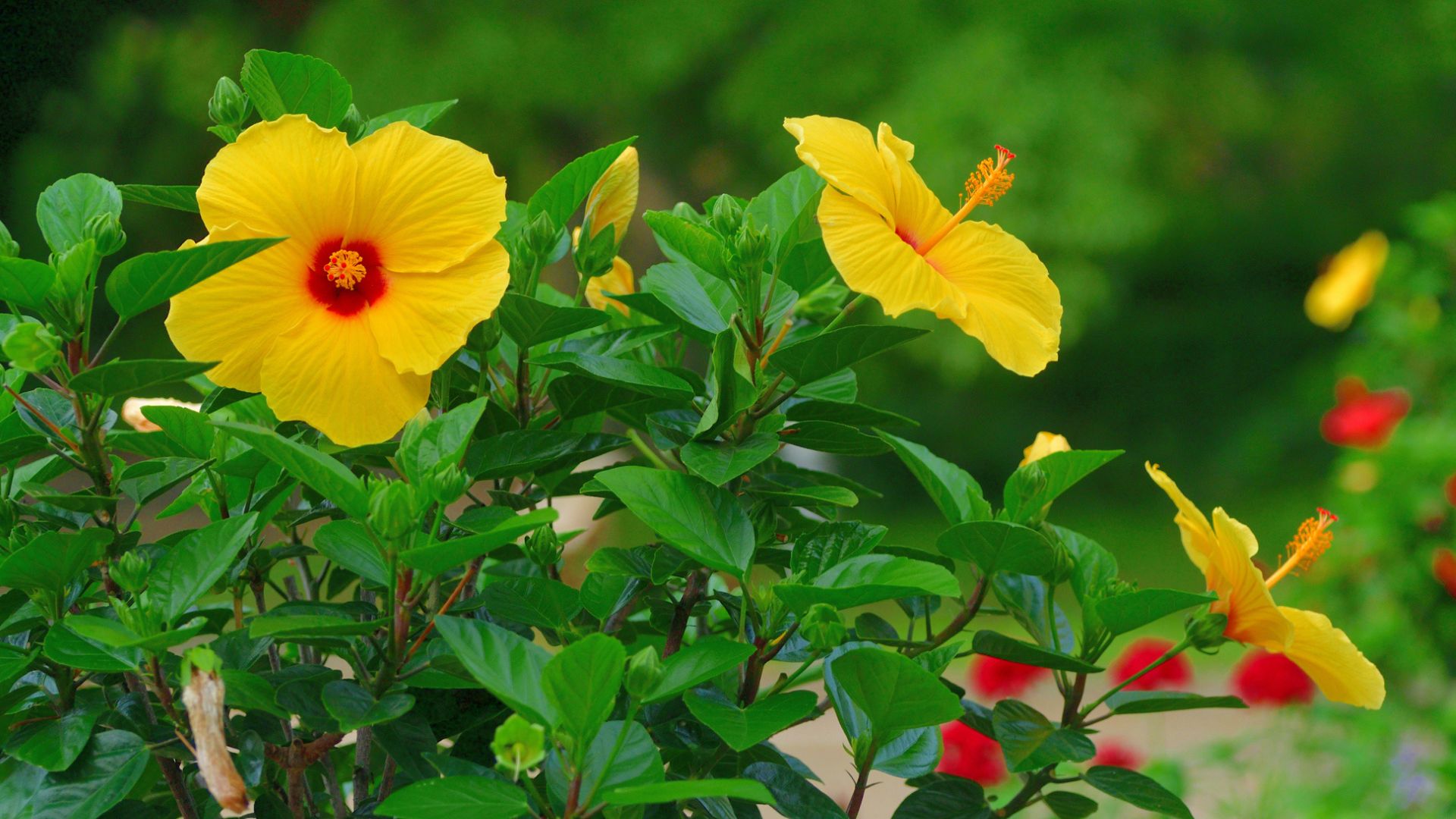Top 10 Questions About Hibiscus Plants


Here at Gardening Know How we get lots of questions, and we want to answer them as best as possible. No question is too big or too small, and we know that sometimes a single plant can bring up all kinds of questions. Hibiscus is a very popular houseplant, and one that may bring up plenty of questions. The following information includes the 10 most commonly asked questions relating to hibiscus.
1) What causes yellow leaves on hibiscus? Yellowing leaves is one of the most common problems with hibiscus plants. Luckily, it's rarely serious and usually easy to fix. It can signal all kinds of different problems, so you'll have to use context to figure out which it might be. Yellow leaves might be caused by too little or too much water, too much or too little light, not enough nutrients, or conditions that are too hot or too cold. Take stock of how you've been treating your hibiscus and change anything you think might be too extreme, then wait and see if the leaves green up.
2) What causes bud drop on hibiscus plants? Bud or blossom drop on hibiscus is usually due to pest problems, and the most common culprits are thrips and gall midge. Both of these insects feed on hibiscus buds, making them fall off before they bloom. If gall midge is your problem, you'll find their larvae inside dropped buds if you cut them open. Both pests can be controlled by a weekly spraying of insecticide. If pests don't seem to be present, bud drop can also be a signal of poor health due to improper watering or feeding, or sharp changes in temperature.
3) What pest is eating my hibiscus plant? There are several pests that target hibiscus plants. Some of the most common include sap sucking insects like spider mites, mealybugs, aphids, and whiteflies. Thrips, gall midge, and hibiscus beetles also attack the plants. These pests should all be able to be treated with a regular application of insecticide. One very effective and safe insecticide is Neem oil, which can be sprayed directly on the leaves or applied to the soil to be drawn up into the plant through the roots. Apply Neem oil once per week in the evening - low light and cooler temperatures are best for preventing damage to the leaves.
4) How do I prune a Hibiscus? Hibiscus plants thrive on a good pruning and should be cut back once per year. The best time by far for hibiscus pruning is early spring. You can cut back a hibiscus pretty aggressively just as it's coming out of its dormancy - this will encourage bushier growth and more buds. Cut off about a third of each branch, leaving 2 to 3 healthy nodes. Completely cut away any dead or unhealthy branches. You can prune your hibiscus less dramatically during the summer and early autumn, too. This will encourage more compact growth, but it will lose some potential for flowering. Avoid pruning at all in late fall and winter.
5) How do I care for a hibiscus in winter? The hibiscus is a hot weather plant that can't handle cold winter temperatures. If your climate experiences more than one or two days below freezing each winter, you'll have to bring it indoors. Place it somewhere that receives at least some light and has a temperature of at least 50 F. (10 C.). Water it occasionally, but only when the soil is dry to the touch. If you're overwintering your hibiscus indoors, expect it to go dormant and look much drabber than it did during the summer. The flowers will fade and some of the leaves might turn yellow, but this is completely normal.
6) Why isn't my hibiscus blooming? Maybe your hibiscus looks very healthy but just isn't blooming. This is a more common problem than you might think, and it has a very reasonable explanation. Your hibiscus isn't sick - it's just lacking in phosphorus. Phosphorus is key to a plant's ability to produce flowers, and it gets depleted over time. If your hibiscus isn't blooming like it should, work some phosphorus into the soil. You can buy phosphorus rich fertilizer, but you can also use bone meal, rock phosphate, or rich compost. It's very hard to give plants too much phosphorus because they have difficulty absorbing it, so don't worry about overdoing it.
Sign up for the Gardening Know How newsletter today and receive a free copy of our e-book "How to Grow Delicious Tomatoes".
7) Why is my hibiscus dropping its leaves? Hibiscus leaf drop is very closely related to leaf yellowing - a lot of the time the two go hand in hand. This means the two are usually caused by the same problems. These can be too much or too little water, too much or too little light, too much or too little fertilizer, or too high or too low of a temperature. These can all be corrected easily. It's also not uncommon to experience a little leaf drop when you bring your hibiscus inside for the winter - this is normal and shouldn't be a problem.
8) How do I propagate a Hibiscus? Hibiscus can be propagated both from seeds and cuttings. Most gardeners prefer using cuttings because it guarantees that the plant will look the same as its parent. Cuttings should be taken in spring or early summer, when the new growth is young and green. Cut a 4- to 6-inch length just below a node. Remove all but the top set of leaves, dip the end in rooting hormone, and sink the cutting in a pot of well-draining soil. Cover it with a plastic bag and place it out of direct sunlight. Keep the soil moist.
9) How much sunlight does a Hibiscus need? While you often hear that hibiscus plants need full sun, this isn't necessarily the case. They will grow and bloom perfectly well on a windowsill where they receive just 2 to 4 hours of sun per day given adequate care. Even outdoors, the amount of sunlight a hibiscus needs depends on climate. In temperate zones, the plants will thrive in full sun. The hotter your summer, however, the more shade your hibiscus will prefer - the plants are known to languish in the full sun of the southern U.S. If you live in a highly numbered zone, plant your hibiscus in a partly shaded spot.
10) How do I transplant a Hibiscus? The best time to transplant a hibiscus is just after its flowers have faded - in most climates this will be in late summer or early autumn. The first thing you should do is dig a hole in your plant's new location. Next, trim your hibiscus back to about ⅓ of its size. This may feel drastic, but it will do a lot to help the plant overcome root shock. Water the plant, then dig a circle 1 foot away from the trunk for every inch of trunk diameter. Place it in its new home so the soil line is at the same level. Fill in with compost and soil and water thoroughly.
We all have questions now and then, whether long-time gardeners or those just starting out. So if you have a gardening question, get a gardening answer. We're always here to help.

The only child of a horticulturist and an English teacher, Liz Baessler was destined to become a gardening editor. She has been with Gardening Know how since 2015, and a Senior Editor since 2020. She holds a BA in English from Brandeis University and an MA in English from the University of Geneva, Switzerland. After years of gardening in containers and community garden plots, she finally has a backyard of her own, which she is systematically filling with vegetables and flowers.